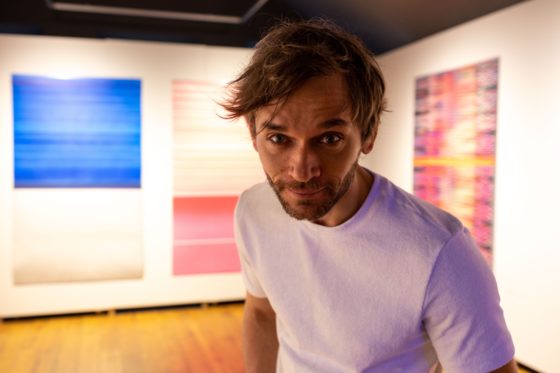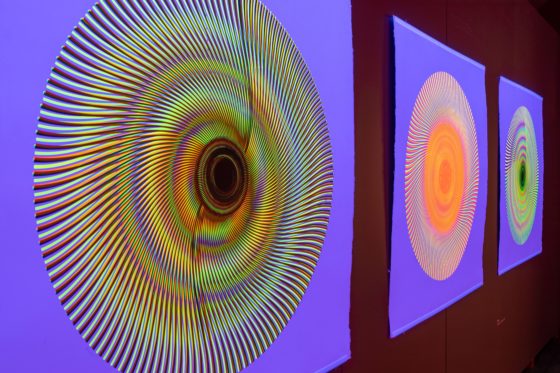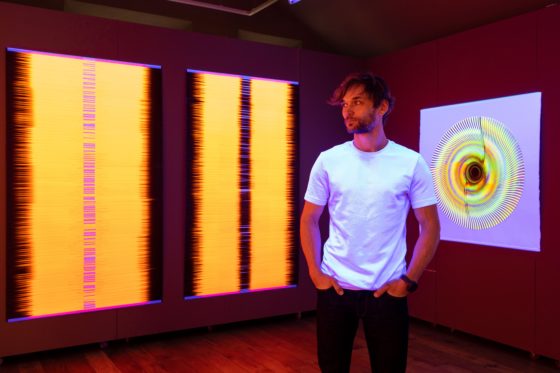Piotr Skowron
– You are an engineer, right?

– Yes, I have a technical education. I graduated from the Polytechnic University in my native Łódź as a communications engineer. Before that, in lyceum, I specialised in mathematics and physics, so it seemed logical to stay on that path. It was a sure and free pass into adulthood. However, at one point, I thought it couldn’t be very exciting to be an engineer for the rest of one’s life. I mean, what about childhood dreams?
– Where do these dreams come from? You were a physics and mathematics buff, so where did you catch an art bug?
– My maternal uncles would bring easels and brushes on their visits to my parents… The smell of paint and turpentine – for me, it was the stuff of magic, pure chemistry! I was amazed at how a painting could almost magically appear on what had just been an empty canvas. That’s how I got into drawing.
The Academy had a prep course. I went there just for the fun of it, simply to draw and do at least something for my childhood dream to become an artist. That’s when it became clear that I was actually good at it. So I thought – why not give it a go? I applied for the evening programme, which ran three days a week, Fridays and weekends, across five years. Along the way, I became fascinated with graphics. Plus, I got offered a teaching post at the Academy.
– Do you remember the moment it hit you that you belong to the ‘creative circles’?
– I guess not (laughs). I’m actually quite shy, so I can’t say I belong to this sophisticated community, the regular patrons of art salons or highbrow spiritual artists. I surely don’t feel like a bon vivant (laughs). Due to my background in engineering and the kind of work that I do, which demands a different sort of skills, not the free flight of thought, I have never dived deep into this world.
– An engineer artist – how does it work in practical terms?
– I work on a large scale and use my technical mind to figure out how to do something cool with exact sciences. To put it simply, I engineer things. Because the large scale demands a different approach to the small. When the works are up on the wall, I can step back and see what I’ve made. That’s when I put on my artist’s hat and asses my work: “Right, this is good.” (laughs)
– You say your work has these structural components: a carefully planned composition, colour, line and plane. Which is your obvious priority?
– Colour and composition. In fact, the two are very close. As to the scale, it makes a difference in how one perceives colour – the tone won’t be as pure and magnetic in smaller pieces. The work needs to be large for the scale to work. Take Rothko, his larger paintings – they have such an incredible impact on the viewer! By composition, I also mean more than one artwork; you can also see it in series… So hard to say – it’s like asking which hand is more important, right or left.
– What inspires you to create?

– Globally, I’d say at first it was Mark Rothko – a massive experience and inspiration. My early works – mostly dark and sombre – had lots of lines. They looked quite different from my current output and, in some sense, were like carbon copies of Rothko. With time, I began to introduce colour. My ‘Rothko period’ came to an end, and the work became more mathematical, geometric, compositional and constructive. I started using the line raster. It’s a technique they once used in newspaper printing, where images were compiled from tiny dots or pixels. The same principle works with lines. When you put them in sequence or overlay, place them at different angles or shift between thick and thin. That’s how you get images with interference. A bit like when you throw pebbles into a body of water. You get overlapping waves that create patterns. And you study them. So I notice how they interact and affect me when I move. I look at the colour and how it changes. One might say I’m inspired by a shall-we-try-this mentality, which can trigger a brainstorm. And every subsequent work needs to be different from its predecessor. So when I improve my works, I must decide how to change them so everything clicks into place.
I’m also inspired by searching and getting a good result. The joy of working and gratification are rich sources of inspiration. But in my case, it’s a slow process. I’m often displeased with the result and want to improve things. As to critique, that’s the engine that keeps me going. So I don’t sit on my bum saying: “Boy, this is it, I’m so cool!” (laughs). Nope. One needs some unrest.
– Do you have people breathing down your neck?
– Yes and no. Not any more. We all do our own thing. I make large-scale prints. That’s relatively rare. That’s my little corner, my territory. Sure, we, artists, will get together and discuss our work. But you have to be a diplomat. If you tell someone: “Hey, this is poor”, you need to accept you might lose a friend (laughs).
– How long do you suppose you’ll pursue this direction? Is there a ceiling you will eventually hit?
– That’s an excellent question because I don’t have an answer (laughs).
You know, as a student, I got fascinated with overlapping lines. That’s when I developed this style (for lack of a better word) – through painful and gruelling discovery. In time, I could predict the outcome with increasing clarity and speed. Satisfying results were becoming more frequent. On the other hand, I lost the drive. The fuel for my unrest was running low, and I started to move away. So for my PhD thesis, I thought I wanted something new and fresh. And I thought about the Universe, about graphic art stepping off the wall and becoming an installation. Through both-sided print. Then came the fluorescent paint.
Yes, I’m extremely curious about linear order, eliminating confusion and just using the linear raster to construct interferential works. To delve into the mysteries of patterns, their interaction and internal logic – why, that’s a never-ending story, a bottomless well. Then again, my excitement is starting to wear. Time to begin something new.
Before coming here to the Rothko Centre, I launched a new research project around lenticular print. The principle was once used in birthday cards – you look from one side, and it’s one thing, but just shift the angle, and it’s a whole different picture. That said, I’m still afraid to get stuck in the linear theme.
– Your solo show at the Rothko Centre, what’s it about?

– Oh, at first talk of me having a show here, to tell you the truth, I got scared (laughs). Such a quality bar to clear! And just imagine the responsibility! Would I be worthy? But in fact, I really wanted to come – as compensation for my creative beginnings. After all, Rothko had and still has a massive influence on my artist’s journey. So here I’m showing my latest pieces, my current work. The patterns of interference.
The circles I’m working on now are pure geometric abstraction. There’s no need to look for depth, like in Rothko’s paintings that touch your very soul. My work embodies my mathematics, my logical approach to life, my calculus.
With this exhibition, I want to say that art needn’t always be very profound. I don’t mean to joke about art, but one doesn’t need depth at all costs. Sometimes a painting can be just that – a painting. Something one will look at and say – no, thanks, all this fluorescence (and what’s with the odd technique?), no, not my thing. And go into another room to find something else. Or someone would say – what pulsing colour, what power, what joy! What incredible energy – yes, I love it! These works are hypnotic. The optical game, the way colours bleed into one anotther. That’s what the show is about. Plus, the two works on the end wall, rose-on-silver and silver-on-blue, are my homage to the Master. My way of connecting the exhibition with the site. Showing my Rothko-inspired pursuits.
– Do you have a personal philosophy, an affirmation or simply a word that keeps you going forward…
– (laughs hard)
– ???
– You know, there’s this one word, only it’s not fit for print (laughs): “k****-k****-k****!” That’s a Polish word known to every Pole, guaranteed to ease the tension when things get hot. Especially if repeated multiple times (laughs). On a serious note… Richard Feynman, the famous physics Professor, said something like this: “It is my task to convince you not to turn away because you don’t understand it. You see, my physics students don’t understand it either… That is because I don’t understand it. Nobody does.” I remember and consistently apply his words to myself: I demand things from myself, only then from my students.
